|
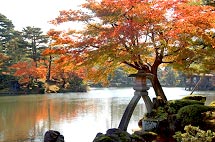 |
|
Kenrokuen Garden
Kenrokuen is
justifiably classified as one of Japan's "three most beautiful
landscape gardens" alongside Mito's Kairakuen, and Okayama's Korakuen.
In fact, many people consider it the best of them all. The garden was
constructed by the ruling Maeda family over a period of nearly two
centuries. It is located in the center of Kanazawa city. Also it has
been considered as a garden where people can appreciate the beauty of
four seasons and loved by many local people as well as by foreign
tourists. Map |
|
|
 |
|
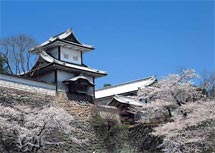 |
|
Kanazawa
Castle Park
Kanazawa Castle
was founded in 1583 when the Maeda family moved to Kanazawa to
establish the Kaga Domain. Ishikawa-mon Gate and The Sanjukken Nagaya
have been designated as a National Important Cultural Asset. It has
been called Kanazawa Castle Park together with the Hishi Yagura turret,
Gojikken Nagaya warehouse, and Hashizume-mon Tsuzuki Yagura turret that
were restored in 2001. Map |
|
|
 |
|
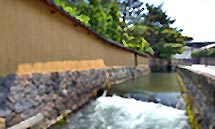
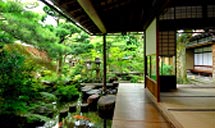 |
|
Nagamachi Buke
yashiki District
and the Nomura Family House
It is the site of
samurai residences for Kaga lords and middle-class samurai warriors.
The ochre-colored earthen walls with bushimado (samurai window) recall
the atmosphere of those days. "Komo," which protects the earthen walls
from snow is typical Kanazawa winter scenery. The site includes the
Nomura Family House, which is open to the public, and Naga-machi Yuzen
Kan(former 'Saihitsuan') where the manufacturing process of Kaga Yuzen
is carried out. Map |
|
|
 |
|
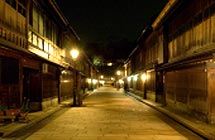 |
|
Higashi Chaya District
Higashi Chaya
District is the most prestigious and grandest of the remaining three
streets in Kanazawa and has been designated as a site of Important
Traditional Japanese Architecture. "Chaya"houses with red-brown
lattices line a narrow stone road. The area still remains the
atmosphere of Bunsei period (1820). Map |
|
|
 |
|
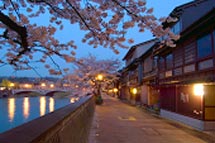 |
|
Kazuemachi Chaya
District
The Chaya
district is on the banks of the Asanogawa River. It is one of the three
streets in Kanazawa It becomes even more attractive in the evening. The
district has been designated as a site of Important Traditional
Japanese Architecture. You can thoroughly enjoy Japanese style dinner
with the beautiful scenery around. Map |
|
|
 |
|
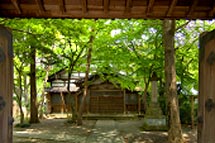 |
|
Utatsuyama Temple Area
Utatsuyama
Temple Area is one of the temple districts in Kanazawa, crowded with 53
temples and shrines. The Maeda family, who ruled the Kaga Domain (the
present Ishikawa and Toyama areas) collected shrines and temples in
this district. It is a quiet walk course where your heart will settle
down. You can enjoy a variety of courses according to your convenience.
Visitors can see the interiors of some of the temples and shrines. Map |
|
|
 |
|
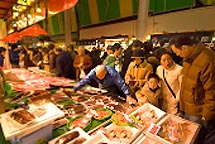 |
|
Omi-cho Market
Omi-cho
Market is a lively open-air food market located in the south-east side
of Musashi area. It is patronized by 180 local household shoppers and
restaurant professionals. They sell unique "Kaga-yasai "(Traditional
Vegetables of Ishikawa Prefecture) such as Hetamurasaki-nasu
(eggplant), Kinjisou (green leaf) and Kagafuto-kyuuri (cucumber) as
well as local fresh seafood. You can enjoy those local foods at the
restaurants in the market Map |
|
|
 |
|
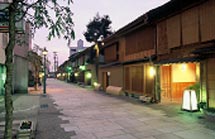 |
|
Nishi Chaya District
Nishi Chaya
District is the smallest one among three streets in Kanazawa. However
even today, Japanese-style restaurants and geisha-girl delivery stores
produce items of great elegance. After dark, the sounds of the shamisen
can be heard, lending the streets further charm. Nishi Chaya Museum is
located in the building where Seijiro Shimada, a writer, lived when
young and there are items exhibited here describing the culture and the
instruments of Teahouses. Map |
|
|
 |
|
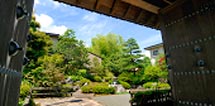
 |
|
Teramachi Temple Area
The Maeda
family, who ruled the Kaga Domain (the present Ishikawa and Toyama
areas) in feudal times, gathered approximately 70 temples along the
south side of the Saigawa River. Myoryuji temple famlous as
"Ninjadera". Shougetsuji temple is famlous for its cherry tree.
Daienji, Gannenji, Uhouin, Ryuenji, Kongohji, Hongakuji, Gannenji
temples are also worth visiting as well. Map |
|
|
 |
|
 |
|
Ninja-dera Temple
(Myoryuji Temple)
Myoryuji Temple,
commonly known as Ninjadera ("Ninja Temple"), was built by the Maeda
lords, rulers over the region during the Edo Period. While not actually
associated with ninjas, the temple earned its nicknamed because of its
many deceptive defences. The temple's defences aimed to guard against
intruders or attack, and include hidden tunnels, secret rooms, traps,
and a labyrinth of corridors and staircases. These can be viewed by
guided tour (reservations required at 076-241-0808) held in
Japanese, although excellent English guidebooks are available upon
request. Map |
|
|
 |
|
 |
|
Daijoji Temple
Daijoji Temple
is a Zen temple of Soto sect located in the base of the Daijoji
Mountain. It has a history of more than 700 years and is still one of
the strictest Zen temples in the country. Those who want to learn the
culture of Japan deeply have to learn Buddhism and Zen. The temple also
accepts people who want to stay and experience the life style of Zen
priests. Map |
|
|
 |
|
 |
|
Kanaiwa/Ono-Komachinami
A route
connecting Osaka and Hokkaido via the Sea of Japan was active from the
latter half of the 18th century to the beginning of the 20th century.
The Kanaiwa and Ono areas prospered as a port town on the route in
Kanazawa. Zeniya Gohei from Kanaiwa made a huge fortune from the trade
vessel, Kitamae-bune which carried a variety of products and
information along the coast of the Japan Sea around the end of Edo
period. In the Ono area, in particular, soy sauce has been manufactured
from salt and soybeans carried by ship and subsoil water taken from the
area. Even nowadays you can enjoy the atmosphere of that time. Map |
|
|
 |
|